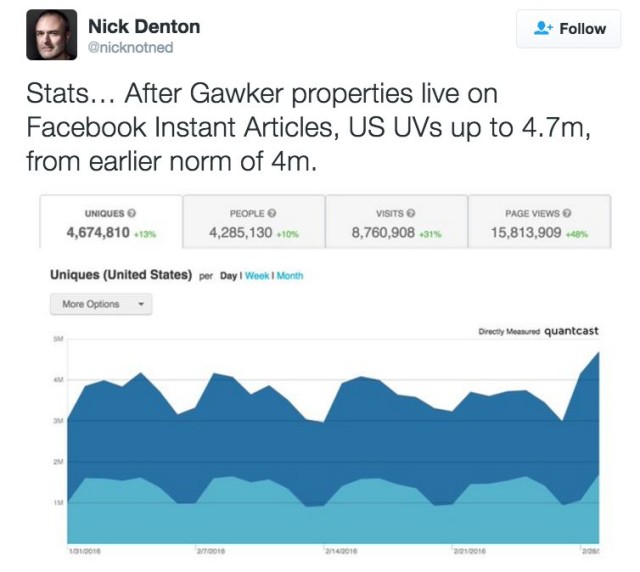Facebook rolled out Instant Articles in May of last year as a way for publishers put content in Facebook’s News Feed so users don’t have to click out and wait for websites to load. This was especially important for mobile devices, where heading to external websites can be slow and often annoying, leading users to switch away from that process all too often. Initially, Instant Articles were limited to a few major publishers, and over time Facebook has gradually increased the access. Now the Instant Articles program will be opened up to all publishers on April 12 at Facebook’s F8 conference, and many new features have been added. Marketers—if you haven’t looked at Instant Articles yet, it’s time you did.
Instant Articles, touted by Facebook as “a new way for publishers to create fast, interactive stories on Facebook,” has been judged a success by publishers and Facebook alike.
The impact of Instant Articles on marketers will be seen in several areas, and it’s expected that giving the general public access to the feature could be huge. The expansion of usage will no doubt be followed by changes as Facebook finds out how Instant Articles is used by millions, and what additional features the masses desire. Still, we can predict certain ways that Instant Articles can be of benefit to marketers.
Audience Growth is a key feature of Instant Articles, and one that’s already been seen by publishers. Gawker Media’s Nick Denton tweeted about the growth in Unique Viewers (UVs) after introducing Instant Articles, boosting UVs from 4 million per day to 4.7 million per day. Part of the audience growth comes from the fast loading of the articles, eliminating the lag associated with heading to an external web site. Users can click through to a publisher’s web site if they want, follow your site on Facebook, or share the article—all of which will increase a publisher’s reach.

Big Data is another useful part of Instant Articles, bringing you actionable intelligence that is not normally part of what a publisher gets from a web site. For instance, Facebook lets you know how far down an article is scrolled, an invaluable way to know just how engaging your articles are—and at what point they lose significant readership.
That sort of data can let you fine-tune content to reach desired objectives. Perhaps there’s no point in writing lengthier articles, so writers should be generating more different articles with fewer paragraphs in them. Or maybe the headlines are bringing in people, but the writing isn’t following up on the promise of the headline. In any case, additional data can help adjust the content strategy top better suit your marketing goals.
Monetization has been an area of concern for Instant Articles, with some publishers concerned about the strict rules for the number of ads within articles. Facebook requires that at least 350 words separate ads in articles, and overall ads cannot make up more than 15 percent of the total content. There are ad platforms that can help out by placing ads at optimal points within articles, such as CodeFuel.
However, Facebook understands that this is an issue for publishers and is taking steps to ameliorate concerns. “Ad tech company Polar is extending support for its platform to Instant Articles, which will enable its clients—among them The Washington Post, The Huffington Post and Slate—to run native ads in their articles there, just as they do with display ads,” notes Digiday in an article on the subject.
“We’ve seen publishers’ feedback on Instant to be positive in terms of the user engagement and content,” said Polar CEO Kunal Gupta. “But there are a lot of questions around how they will monetize it, knowing they have less ad positions on Instant. Branded content is typically the highest margin format the publisher has. This lets them get their highest-value formats into this platform.”
One of the major changes to Instant Articles is in Facebook’s advertising policies, which will now enable publishers to place video ads into content they post on the platform, as well as adding one additional ad unit at the bottom of every Instant Article, which could increase ad impressions by more than 20 percent. “In our conversations with publishers, these changes popped up as the biggest steps we could take to make the biggest impact,” said Josh Roberts, Instant Articles product manager at Facebook.
The Wall Street Journal reported that Facebook, as it prepares to open Instant Articles to all publishers, is making these changes to help with monetization. “Publishers will soon be able to place both autoplay and user-initiated video ads within Instant Articles, and to include pre-roll advertising before any editorial video content they publish, Mr. Roberts said. Autoplay video ads must have their sound disabled, however,” the Wall Street Journal noted. “We care about user experience first and foremost, but we know this doesn’t work if publishers can’t monetize their content successfully,” said Roberts.
It’s important to note that publishers can either sell the ads themselves (and keep 100 percent of the revenue), or pass the ad slot on to Facebook to sell, whereupon the social network will keep 30 percent of whatever revenue it acquires from the sale of that slot. However, the downside for users experiencing these ads is that they can either be autoplay or user-initiated—and there’s no doubt that autoplay ads can be annoying, especially on a mobile device where it can run down your battery life. As usual, much will depend on the discretion and good sense of both publishers and advertisers not to let these issues get out of hand.
There may be more monetization news for Instant Articles in the future, Facebook hinted. The inclusion of sponsored content and the ability to allow publishers to collect email addresses are among changes being considered for Instant Articles as time passes.
Ultimately, the future of Instant Articles depends upon its adoption by publishers and the potentially huge adoption ahead as Facebook opens the platform to all. Brand recognition is a huge part of the value of Instant Articles for marketers, as they load automatically in the News Feed rather than requiring a click to access. The articles also keep all the elements you’ve chosen to include, like your brand logo, special fonts or colors, or other parts of the brand identity. The potential for increased impressions is huge if Instant Articles become as widespread as most observers think.
Gawker Media’s Nick Denton, for one, believes Facebook has the right stuff to make Instant Articles popular. “Who is best positioned in this world to target ads against categories of users?” Denton said, speaking to Re/code. “Who knows the most about those users? Who can supply the most relevant ads and in a way that doesn’t degrade the user experience?”
We’ll no doubt find out more about Instant Articles at Facebook’s F8 developer conference on April 12.

